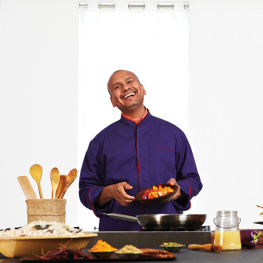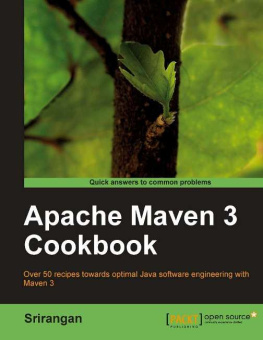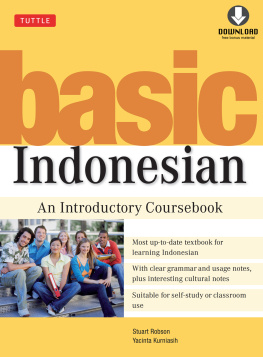Indian Cooking Unfolded
Raghavan Iyer
Workman Publishing New York
Dedication
To my son, Robert, who means the world to me.
To my partner of more than thirty years, Terry, for all the quiet support.
To my family in India, whom I always miss.
And to the tens of thousands of students over the years from whom I continue to learn to teach.
Acknowledgments
Its easy (well, not entirely true) for me as a teacher to stand before an audience and cook away, expounding on all the intricacies of Indian cooking, as I chop, stir, stew, and bake my creations with spicy panache. Truth be told, its the planning and work that have transpired days before that get me to that performance kitchen to entertain and educate. So why would writing a book be any different?
Two key women formulated the course that got my attention: my brilliant, savvy, and knowledgeable agent who has been a champion and friend for all my projects, Jane Dystel. My editor, Suzanne Rafer, who, in my not-so-humble opinion, is the mother of all editorskind, patient, insightful, and with a keen eye for detail. Any writer would kill to work with her. And I am honored to call her a friend. None of this would have been possible if it werent for the two visionaries at Workman, the incomparable Peter Workman himself and the charming Bob Miller.
So recipe writing and testing is underway and you need a bevy of volunteers (did I say you do not get to be a millionaire writing cookbooks?) to test, taste, and critique. Katherine Kunst and Edith Pfeifer List spent some quality time with them and turned in helpful observations. A circle of friends crawl out of the woodwork just in time for dinner claiming to be expertsDr. Jeffrey Mandel, R.J. (Molu) and Tara Singh, Raymond and Terra Vaughn, Jiten and Jennifer Gori, Ben and Zaidee Martin. So many of my colleagues and friends egg me onJim Dodge, Mary Evans, Meredith Deeds, Lee Dean, Paulette Mitchell, Nathan Fong, Lynne Rossetto Kasper, Beth Dooley, Sara Monick, Phyllis Louise Harris, Dorothy Long Sandercock, Leah Mann, Ellen Pruden, Ron Longe, David Joachim, Sharon Sanders, Crescent Dragonwagon, Diane Morgan, and so many more.
Now comes the part when you need someone who is meticulous, once you turn in your manuscript, to copyedit and double-check every line. You need Barbara Mateer and Carol White. Once the words are put in place, how do you make them come alive? Bring in the dazzling Jean-Marc Troadec (bien sr, he is French), designer extraordinaire to shape the pages and splash colors that are vivid, warm, and downright sensuous. He had some great material to work with in terms of photography. Photo Director Anne Kerman orchestrated it all and brought in the amazing (and very pregnant) Lucy Schaeffer to shoot the photos. And wow, did she perform! You just want to eat the pages! And yes, she delivered a beautiful baby girl (not during the shoot!), who is off the cute charts, as well. The one who made the recipes (they worked just fine, thank you very much) and fussed over the dishes for the camera was dashing and masterful food stylist Simon Andrews, ably assisted by Idan Bitton (who was a great stand-in for the author shotmuch better than I). Prop stylist Sara Abalan had an eye (well, two) for grabbing the right stuff to make the food sing. Lets not forget assistant editor Erin Klabundes ability to hold all the strings in place and the work put in by Production Manager Doug Wolff and the typesetting department, Barbara Peragine and Jarrod Dyer. You think indexing would be a piece of cake; well think again, you are sadly mistakenjust ask Cathy Dorsey, who really knows what it takesit can make or break a book!
All this work is fine and dandy but if it does not get the appropriate exposure, you might as well call it quits. No one will know to take that class. So in walks Executive Publicity Director Selina Meere and publicist John Jenkinson to get the job done, as did so many of my other friends at Workman. My friends and partners in my spice line (okay, time for a shameless plugturmerictrail.com), Jennifer Leuck and Beth Gillies, who also operate a successful PR agency, pitched in. Soon word gets around and everyone wants to get in (okay, its my fantasy).
So to all who came to class, learned, provided feedback, and left with a full bellythank you for your support over the years. I learned as much from you as I was able to teach. Unfold this journey with me and savor the moments. You can reach me through my website, )would love to chat.
Contents
Chapter 1
The Easy Breezy Indian
I was still exhausted from the twenty-four-hour flight as the car driven by a family friend made its way through the cornfields of southwestern Minnesota. It was the fall of 1982 and my second day in the United States. Lost in numbed thought, I was beginning to fully understand that I was alone and for the first time away from my familiar life in Mumbai. Panic washed over me as the white station wagon approached the small town of Marshall, and the four-story buildings of the university campus towered above the flat fields. What was I doing here? What was I going to do for meals? My dormitory arrangements did not include a meal plan. It quickly became obvious to me that this town would not have restaurants that served the food I was accustomed to, especially since I was, like many Indians, a sucker for spice. Why hadnt I heeded my sisters advice to learn at least the basics of cooking my childhood favorites?
An hour later, standing amid the clutter of my large suitcases in the small dorm room, I pried open a window to watch my friend drive away. I had known that leaving home would be the start of a journey, but the whiff of the chilled autumn breeze carrying the fresh-mowed-grass smell of harvested corn mixed with the acrid odor of pig farms offered no clue to the culinary odyssey ahead of me.
The first meals I conjured up in my dormitorys kitchen were pitifully pathetic. I was uneasy, but took some comfort in the contents of a white rectangular tin with green and red letters that spelled Curry Powder as I added it to overboiled, nutritionally devoid vegetables. Another aid was the bottle of red pepper flakes that accompanied me to restaurants. I pulled it out to perk up everything from mashed potatoes to macaroni and cheeseembarrassing my dinner companions. In the neighborhoods supermarket I found no traces of black mustard seeds, chiles, or bunches of fresh coriander leaves (called cilantro in this country, I later learned), indispensable ingredients in many of the dishes I had come to love during my childhood in Mumbai. However I discovered potatoes, onions, tomatoes, and corn were abundant and so were yellow mustard seeds (used in the ground form along with turmeric in the Western cultures production of prepared mustard), green and yellow split peas (to make split pea soup with ham hocks), ground red (cayenne) pepper (used in minimal quantities to spike deviled eggs), and parsley (the quintessential herb in providing a sprig of spring green to umpteen plates as garnish).
Without realizing it, I was learning to use readily available ingredients to create spicing techniques that brought assertive flavors into my new Midwestern American home kitchen. My education and expertise in the culinary field flourished, and I learned that in fact the everyday grocery store stock did include many of the ingredients I was familiar with from my upbringing. What struck me as being ironic was that I, an Indian by nationality, was learning to cook the Indian way in a foreign land. Like Americans, I was experiencing firsthand the challenges Americans face in trying to procure distinctive ethnic ingredients. My task was to create the complexity of the Indian flavors I craved by using what I could find in a mainstream grocery store, eliminating the need to locate an Indian store, in person or virtually. Could it be done? The answer is an unequivocally simple yes. And thats what this cookbook is all about.


















